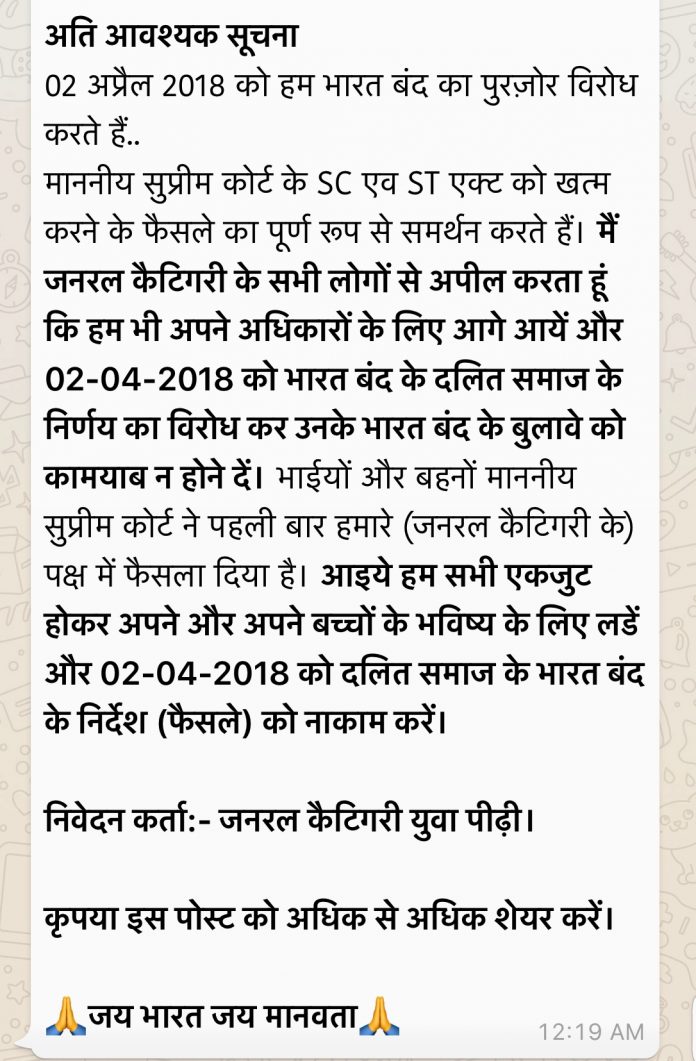By Siddhant Mohan, TwoCircles.net
The foundations of the Bharat Bandh, which took place on April 2, was laid on March 20, when the Supreme Court verdict pertaining to SC/ST Act came out. Over the next 12 days, a series of WhatsApp messages started making rounds asking citizens to take part in the protests and raise their voice.
But while people who supported the protests went on a WhatsApp overdrive, a parallel set of WhatsApp messages was also being circulated, especially among Savarnas asking people to not take any part in such protests. A number of such messages even asked users to take to the streets and protest against the protest march called by the Dalit-Adivasi communities.
What is even more interesting is that most of these messages were specifically targeted to the cellphones of users who belonged to the upper-caste community. Alok Kumar Sharma, a 32-year-old salesperson based in Varanasi, confirmed this. “It was maybe March 29 when I received one such message. And it was not from a WhatsApp group or so. I received the message from a personal number. As the protest day came closer, I was getting five or six such messages every day. Now the relatives and close friends too were sending same messages,” he said, adding that his younger brother had also been receiving such messages.
Satish Singh, a 22-year-old student living in Samastipur, said, “I did not receive the messages initially. But it started soon after I talked to several of my college friends about the Bharat Bandh protest.” He said, “I did not take part in any such protest. But I know many of my upper caste friends who went to those events.”
If one looks at the quality and content of such messages, it sure looks like they were composed to target the audience between 20-40 age groups. Examples of few such messages are:
1.
Important Notice:
I, as a young citizen of India, welcome Hon’ble Supreme Court’s judgment regarding SC/ST Act. I appeal to the people of General Category to come out at the front for our rights and let’s unite against Dalit community’s call to protest against the decision. We must not let them succeed. For the very first time in history, the Supreme Court has given any verdict in favor of General Category community, and that must sustain.
Jai Bharat! Jai Manavta!
2.
Shapath (The Oath)
My fellow brother! I have lost many things in our lives. Muslims took away our peace, our families, our ancestors and then our country. And since many years, I have been giving away my many rights to these Dalits, who never did anything other than to feed and live on what was mine. This is the first time the top court has made the call for equality among the community. I must stand to protect the same. And I request you to come out your comfortable homes on April 2, and let us show these people what it means to lose everything to them.
3.
Silence is everything which reduced my opportunities in this life. I was born Savarna, but this was not my fault. I lost admission to a good school, even after having some good marks, that was not my fault. I lost the job opportunity in a government institute, that is not mine fault too. Whose fault was that? Do not you know?
But when I am going to stand against these atrocities on me on April 2, media will make that my fault. But we both know that this won’t be mine. So let us stand for the right and stand with the power to take back what has been supposed to be ours.
Apart from these messages, there were many messages which appealed to “teach a lesson to these Chamars!” or trying to incite violence in clear words.
The Police across many states have been trying to decode the real cause behind the violence around Bharat Bandh protests. Police sources claim that Social Media and WhatsApp messages sent in various groups are being observed to trace the turnout of violent elements at protest sites.
Rakesh Sundaram, a freelance IT expert from IIT-BHU explained how WhatsApp messages could be used to target a certain audience who belong to the Savarna community. “The basic algorithm between Facebook and WhatsApp is connected. You don’t have to provide age details on WhatsApp as opposed to Facebook, but we often forget that both are owned by the same company.
“I am not saying that the Facebook is directly involved, but through Facebook, you unwillingly submit yourself to many things including hate propaganda,” he said, adding, “These are not bots, these are people who chose you through your background.”
The message trend was observed especially in the many areas of Uttar Pradesh and Bihar. Lenin Raghuvanshi, a human rights activist based in Varanasi, said, “This has been a trend when any such anti-government agitation happens in India. These are planned approaches to totally deviate the attention from the main agenda.”
Many accuse Rashtriya Swayamsevak Sangh (RSS) and other allied Hindutva organizations behind spreading such hate messages out to the public, but Sangh sources inform that they merely forwarded the messages sent to them. One source from Lucknow said, “I received three messages in a row from my Prant Pracharak (a state level leader in RSS), and he asked me to spread this among others. I just did that.”
The RSS leader Bhaiyaji Joshi denied any such involvement in the violent incidents, even after expressing his views over caste-based reservation openly. In a press release, he said, “The tasks to malign the name of the Sangh is objectionable and baseless. Sangh has no affiliation with the decision made by Supreme Court of India regarding the SC/ST Act.”


